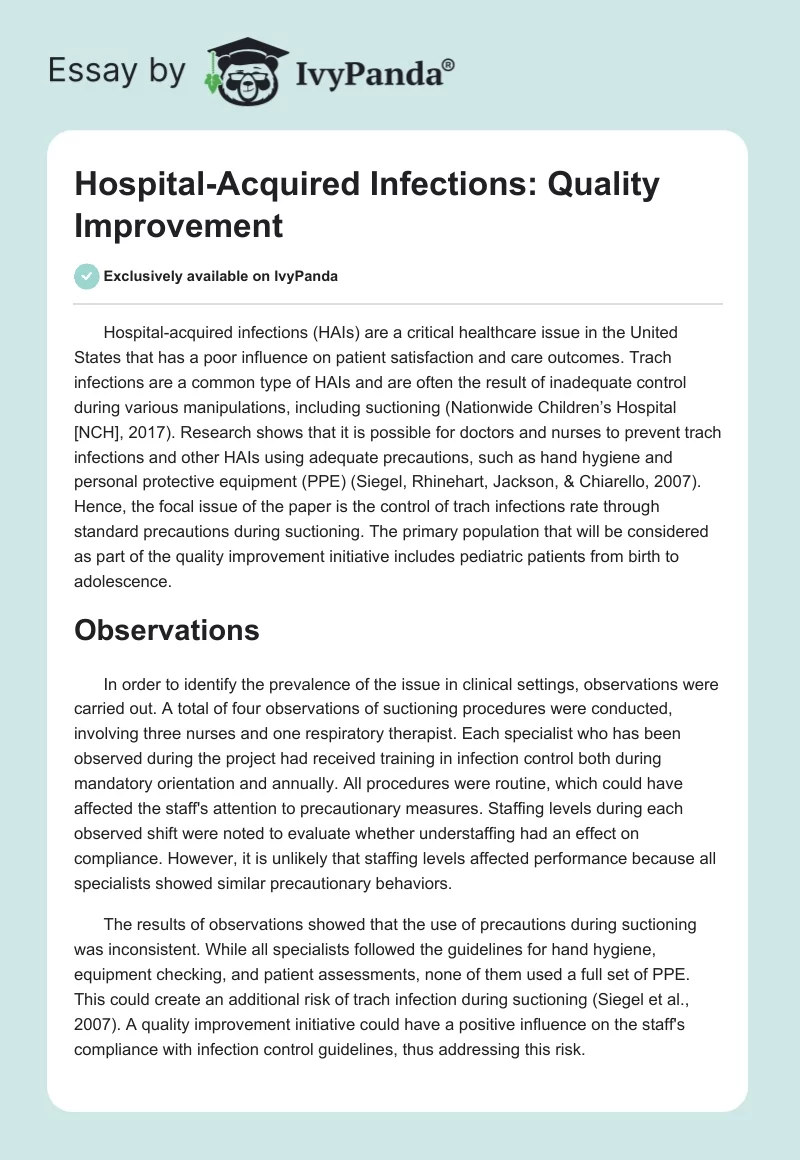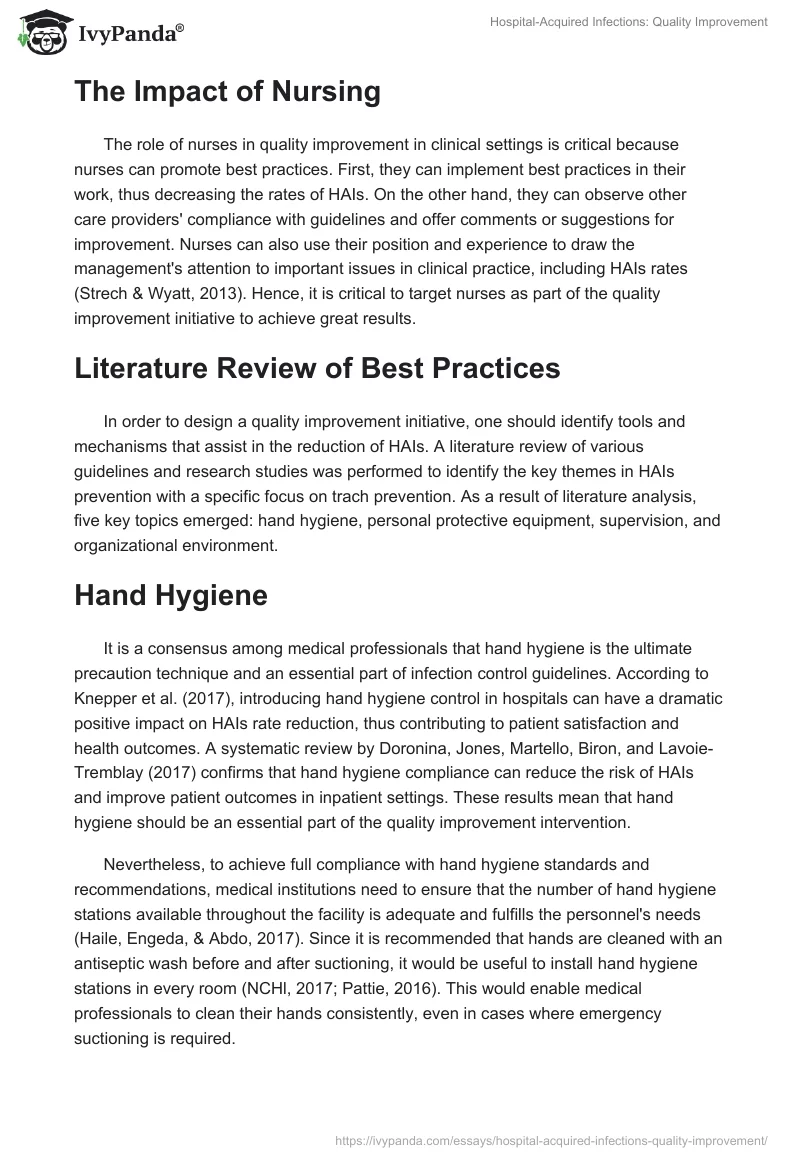Hospital-acquired infections (HAIs) are a critical healthcare issue in the United States that has a poor influence on patient satisfaction and care outcomes. Trach infections are a common type of HAIs and are often the result of inadequate control during various manipulations, including suctioning (Nationwide Children’s Hospital [NCH], 2017). Research shows that it is possible for doctors and nurses to prevent trach infections and other HAIs using adequate precautions, such as hand hygiene and personal protective equipment (PPE) (Siegel, Rhinehart, Jackson, & Chiarello, 2007). Hence, the focal issue of the paper is the control of trach infections rate through standard precautions during suctioning. The primary population that will be considered as part of the quality improvement initiative includes pediatric patients from birth to adolescence.
Observations
In order to identify the prevalence of the issue in clinical settings, observations were carried out. A total of four observations of suctioning procedures were conducted, involving three nurses and one respiratory therapist. Each specialist who has been observed during the project had received training in infection control both during mandatory orientation and annually. All procedures were routine, which could have affected the staff’s attention to precautionary measures. Staffing levels during each observed shift were noted to evaluate whether understaffing had an effect on compliance. However, it is unlikely that staffing levels affected performance because all specialists showed similar precautionary behaviors.
The results of observations showed that the use of precautions during suctioning was inconsistent. While all specialists followed the guidelines for hand hygiene, equipment checking, and patient assessments, none of them used a full set of PPE. This could create an additional risk of trach infection during suctioning (Siegel et al., 2007). A quality improvement initiative could have a positive influence on the staff’s compliance with infection control guidelines, thus addressing this risk.
The Impact of Nursing
The role of nurses in quality improvement in clinical settings is critical because nurses can promote best practices. First, they can implement best practices in their work, thus decreasing the rates of HAIs. On the other hand, they can observe other care providers’ compliance with guidelines and offer comments or suggestions for improvement. Nurses can also use their position and experience to draw the management’s attention to important issues in clinical practice, including HAIs rates (Strech & Wyatt, 2013). Hence, it is critical to target nurses as part of the quality improvement initiative to achieve great results.
Literature Review of Best Practices
In order to design a quality improvement initiative, one should identify tools and mechanisms that assist in the reduction of HAIs. A literature review of various guidelines and research studies was performed to identify the key themes in HAIs prevention with a specific focus on trach prevention. As a result of literature analysis, five key topics emerged: hand hygiene, personal protective equipment, supervision, and organizational environment.
Hand Hygiene
It is a consensus among medical professionals that hand hygiene is the ultimate precaution technique and an essential part of infection control guidelines. According to Knepper et al. (2017), introducing hand hygiene control in hospitals can have a dramatic positive impact on HAIs rate reduction, thus contributing to patient satisfaction and health outcomes. A systematic review by Doronina, Jones, Martello, Biron, and Lavoie-Tremblay (2017) confirms that hand hygiene compliance can reduce the risk of HAIs and improve patient outcomes in inpatient settings. These results mean that hand hygiene should be an essential part of the quality improvement intervention.
Nevertheless, to achieve full compliance with hand hygiene standards and recommendations, medical institutions need to ensure that the number of hand hygiene stations available throughout the facility is adequate and fulfills the personnel’s needs (Haile, Engeda, & Abdo, 2017). Since it is recommended that hands are cleaned with an antiseptic wash before and after suctioning, it would be useful to install hand hygiene stations in every room (NCHl, 2017; Pattie, 2016). This would enable medical professionals to clean their hands consistently, even in cases where emergency suctioning is required.
Personal Protective Equipment
Another helpful precaution recommended by most guidelines and confirmed by research studies is the use of PPE. The guidelines by Pattie (2016) and Siegel et al. (2007) mention that the use of PPE can prevent the transmission of infections from care providers to patients and vice versa during suctioning and other high-risk manipulations. The guidelines recommend providers to wear a full PPE set including gloves, a mask, and a gown during the process of suctioning (Siegel et al., 2007). However, the need for the consistent use of PPE requires hospitals to consider barriers to PPE utilization, including access and availability. Haile et al. (2017) show that care providers need to have full access to PPE kits at all times, which means that medical institutions should have enough PPE kits located in different rooms for easy retrieval. Hence, the quality improvement should focus on making PPE kits available and provide additional education to medical professionals regarding the necessity to use PPE during suctioning.
Clinical Supervision
Another strategy that could fit into the proposed quality improvement initiative is clinical supervision, which involves medical professionals overseeing their colleague’s compliance with standards and guidelines. Clinical supervision can be either full or partial, depending on the needs of the workforce. Full clinical supervision means that all procedures and staff members are supervised by others, whereas partial supervision only requires oversight of high-risk procedures and employees with limited experience (Snowdon, Leggat, & Taylor, 2017). As shown in the study by Showdon et al. (2017), clinical supervision showed a positive correlation with guideline compliance and improved patient-reported quality of care. In the proposed intervention, clinical supervision should be supported by other strategies for quality improvement.
Organizational Environment and Workload
It is essential for managers to consider organizational influences that could undermine compliance and intervention efficiency. There is evidence that staffing levels are positively linked to nurses’ compliance with infection control, meaning that understaffing poses a threat to patient outcomes (Twigg, Gelder, & Myers, 2015). This is probably because understaffing results in increased workload, causing nurses to forget about or disregard precautions (Twigg et al., 2015). Hence, leaders and managers should monitor staffing rates and ensure that nurses can attend to each patient without rushing.
Quality Improvement Initiative
Overall, the proposed quality improvement initiative is comprehensive and involves all the evidence-based strategies discussed above. First, the institution should update its standards for infection control in accordance with current guidelines. Secondly, managers should evaluate and improve the availability of hand hygiene tools and PPE kits throughout the facility (Haile et al., 2017). The third component of the intervention is additional staff training on the new guidelines to raise awareness of changes and standards. Full clinical supervision should also be implemented for at least one month to evaluate performance and compliance (Snowdon et al., 2017). After that, the facility could switch to partial clinical supervision and monitor the compliance of inexperienced workers. Lastly, staffing rates for every shift should be reviewed, and additional nurses should be hired if necessary (Twigg et al., 2015). These strategies would help to improve the use of precautions during suctioning, thus reducing the risk of trach infections.
The Role of the Nurse Leader
The nurse leader should be in command of the implementation process. They should be responsible for making changes to current infection control standards and employee training. It would also be beneficial for the nurse leader to apply change management theory to ensure that all staff members take part in the change process. At the administrative level, nurse leaders should use a systematic approach to ensuring adequate workload and staffing. The success of the intervention can be measured based on the results of clinical supervision and the rate of hospital-acquired trach infections.
Conclusion
Trach infections can pose a significant threat to patient health and require adequate prevention and control. The observations conducted as part of the assignment showed that the use of precautions is inconsistent, and thus a quality improvement initiative is required. The proposed intervention is based on research evidence and current guidelines and involves several components, such as hand hygiene, PPE use, staff training, workload management, and supervision. The implementation of the initiative will help nurse leaders to reduce the risk of hospital-acquired trach infections and enhance patient outcomes in the facility.
References
Doronina, O., Jones, D., Martello, M., Biron, A., & Lavoie‐Tremblay, M. (2017). A systematic review on the effectiveness of interventions to improve hand hygiene compliance of nurses in the hospital setting. Journal of Nursing Scholarship, 49(2), 143-152.
Haile, T. G., Engeda, E. H., & Abdo, A. A. (2017). Compliance with standard precautions and associated factors among healthcare workers in Gondar University Comprehensive Specialized Hospital, Northwest Ethiopia. Journal of Environmental and Public Health, 2017(2050635), 1-8.
Knepper, B., Miller, A., Reese, S., Kurtz, J., Stella, S., & Young, H. (2017). Electronic hand hygiene monitoring: A tool to drive improvement and measure impact. Open Forum Infectious Diseases, 4(1), S408-S409.
Nationwide Children’s Hospital (NCH). (2017). Tracheostomy care: How to prevent trach infections. Web.
Pattie, S. (2016). Endotracheal tube suction of ventilated neonates. Web.
Siegel, J. D., Rhinehart, E., Jackson, M., & Chiarello, L. (2007).2007 Guideline for isolation precautions preventing transmission of infectious agents in healthcare settings. Web.
Snowdon, D. A., Leggat, S. G., & Taylor, N. F. (2017). Does clinical supervision of healthcare professionals improve effectiveness of care and patient experience? A systematic review. BMC Health Services Research, 17(1), 786-796.
Strech, S., & Wyatt, D. A. (2013). Partnering to lead change: Nurses’ role in the redesign of health care. AORN Journal, 98(3), 260-266. Web.
Twigg, D. E., Gelder, L., & Myers, H. (2015). The impact of understaffed shifts on nurse‐sensitive outcomes. Journal of Advanced Nursing, 71(7), 1564-1572.


